从0到1,十五张图表回顾比特币铭文生态的演变过程
Original author: defioasis, Wu Shuo
Original editor: Colin Wu
(1) Ordinals opens the Bitcoin ecological Pandora’s box

(Data source: https://dune.com/dgtl_assets/bitcoin-ordinals-analysis)
In December 2022, Casey launched the Ordinals protocol, opening the Pandoras box of the Bitcoin ecosystem. The Ordinals protocol gives each satoshi a unique serial number, and any user can engrave additional information on the satoshi, including text, pictures, videos, and 3D models. These inscriptions can be saved in Bitcoin wallets and tracked in Bitcoin transactions, and are immutable and decentralized like Bitcoin. Casey positioned it to preserve something eternal on Bitcoin, which was originally used to create and store NFT collectibles. At present, the number of Bitcoin inscriptions has exceeded 57 million, with a cumulative contribution of more than 230 million US dollars in fees.
(2) Bitcoin Punks leads Ordinals to debut

(Data source: https://geniidata.com/user/orddata/bitcoin-punks)
On February 9, 2023, the first NFT Bitcoin Punks to upload Ethereum CryptoPunks bytes to the Bitcoin chain using the Ordinals protocol sparked heated discussions on social media. At 15:24 pm on February 9, a total of 10,000 Bitcoin Punks were minted in less than two days after their birth. At first, most people did not notice Ordinals, which was just another copy of Punks on different blockchains, until this inscription revolution brought by Ordinals became closely related to everyone.
(3) BRC-20 Ignite Bitcoin Ordinals

(Data source: https://dune.com/dgtl_assets/bitcoin-ordinals-analysis)
In March 2023, anonymous developer domo launched BRC-20 based on the Ordinals protocol. BRC-20 is essentially a specific JSON text file used for transactions. The JSON file is an Ordinal inscription, with a unique number. Each JSON file corresponds to a specific BRC-20. BRC-20 can be regarded as a issuance standard for Bitcoin altcoins, with the characteristics of fair launch. After its launch, BRC-20 quickly ignited Bitcoin Ordinals in a short period of time, and tens of thousands of inscribed tokens were born. Currently, about 95% of the inscriptions on Bitcoin Ordinals are BRC-20 as the main representative text type.
(4) OKX shines in inscription layout

(Data source: https://dune.com/domo/ordinals-marketplaces)
As the first mainstream centralized exchange to enter the Inscription sector, in addition to the analysis and strategies of the research team behind it, the technical reserves of OKLink built by OKX over the years have also exerted an absolute advantage. The experience of the built-in wallet of OKX Web3 Wallet, which may be called the best product innovation of Crypto in 2023, is highly dependent on the service data behind OKLink. The continuous improvement of the stability of back-end services allows the front-end products to be highly consistent with user needs. At present, OKX Web3 Wallet has basically become the first choice for Mingwen users. Its market share in Mingwen’s transaction volume and users has stabilized at more than 60%. From November to December 2023, the market share once remained at 80% -90%. On December 16, when the Bitcoin Ordinals on-chain market transaction volume hit a historic high of over $80 million, OKX Web3 Wallet contributed nearly $74 million in transaction volume.
(5) Sophon sniper robot sweeps BRC-20

(Data source: https://dune.com/queries/3381233)
From the end of September to mid-to-late October 2023, BRC-20 ushered in one of the biggest crises since its birth. The number of minting on the chain almost dropped to 0. This was a project called Sophon invented by the anonymous developer Rijndael. Caused by the BRC-20 sniper robot. Taking advantage of BRC-20’s “first come, first served” deployment mechanism and the public nature of most Bitcoin transactions, the Sophon bot monitors Bitcoin transactions for BRC-20 deployment and then broadcasts the same token code at a higher rate A similar inscription would supersede other BRC-20 deployment transactions, making the BRC-20 they copied official. In addition, Sophon also sets each deployed token to 1, so that each deployed token has only a unique holder and on-chain minting activity comes to a standstill. Fortunately, Rijndael was not a hacker, and Sophon was expensive to run. After running for a while, it was finally shut down and donated to the open source software opensats.
(6) ORDI has been listed on the leading exchanges OKX and Binance.

(Data source: https://coinmarketcap.com/currencies/ordi/)
As the first inscribed token of BRC-20, ORDI has experienced a tens of thousands of times increase from its initial fair launch with only Gas minting to once exceeding $90 in less than a year. In this process, BRC-20 headed by ORDI and the Ordinals protocol behind it are gradually recognized by more users. In May and November 2023, ORDI was listed on the two major exchanges OKX and Binance respectively, and completed a tenfold increase within one month after being listed on Binance. Subsequently, SATS was also listed on Binance and OKX. The listing of ORDI and SATS on leading exchanges allows users to see the exchanges positive attitude towards Inscription assets and look forward to more Inscription tokens being launched online.
(7) Inscription activities take turns to conduct stress tests on major public chains
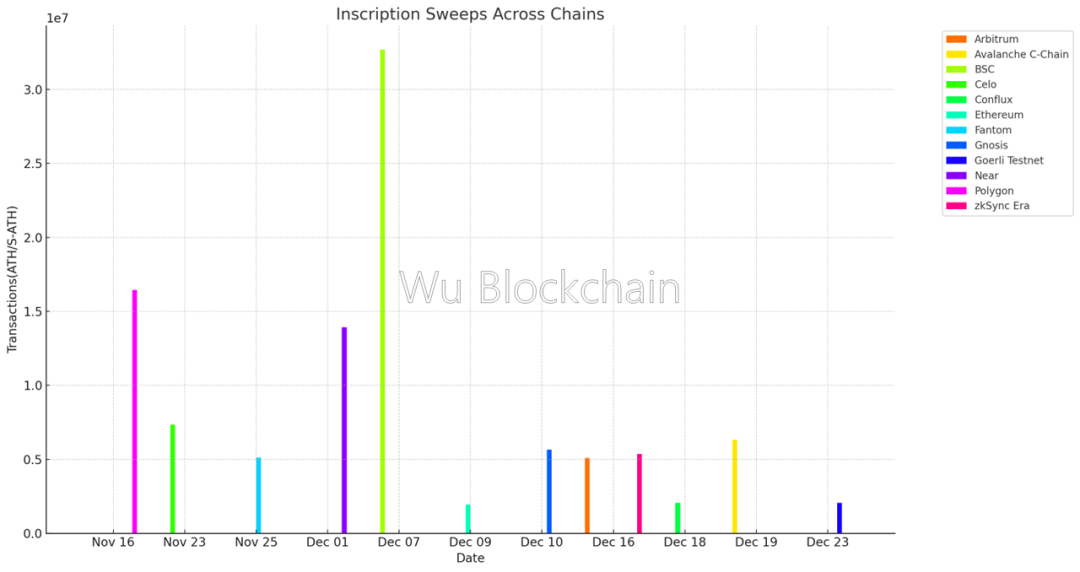
(Data source: Chain Explorer)
From mid-November to December 2023, the abundance of Inscription funds began to overflow from Bitcoin to the major EVM public chains, and the FOMO sentiment about the first Inscription asset quickly spread to the major public chains, and even the test network became a target. object. More than a dozen public chains suddenly burst out with millions or even tens of millions of transactions on a certain day, causing some public chains to go down.
(8) Inscription narrative is expected to become a new potential growth point for Bitcoin miners’ income.

(Data source: https://studio.glassnode.com/metrics?a=BTCcategory=m=fees.VolumeSums=1672531200u=1706198399zoom=)
Driven by the Inscription activity, Bitcoin transaction fees in U.S. dollars reached a record high of $23.69 million on December 16, 2023. Unlike the previous two bull markets, which peaked in a four-year cycle, 2023 is not yet considered a bull market. This also allows miners to see the huge potential of inscriptions to promote transaction fees on the Bitcoin network. Especially with the halving approaching, the halving of earnings may significantly improve the economic income of miners if the demand for inscriptions is sustainable.
(9) External crisis: Bitcoin Core client developer Luke Dashjr requested that inscriptions be disabled
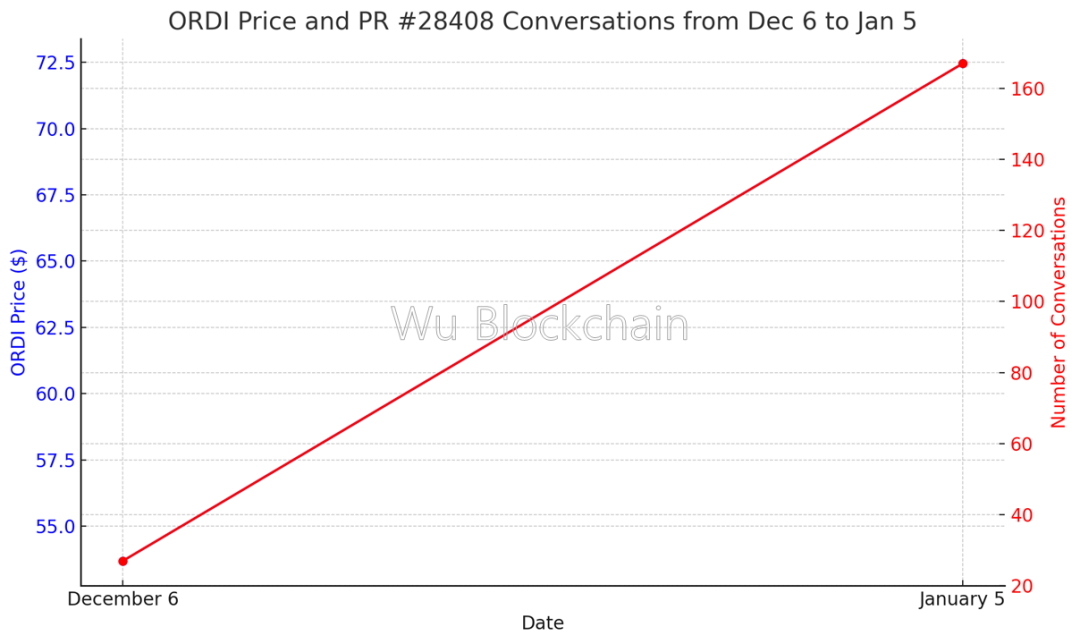
(Data source: https://github.com/bitcoin/bitcoin/pull/28408)
Bitcoin Core client developer Luke Dashjr submitted PR #28408 to Bitcoin Core Github in September 2023, which updated datacarriersize to filter inscription transactions that carry new script data. On December 6, 2023, Luke posted an attack on social media, saying that Inscription was using the vulnerability of Bitcoin Core to conduct spam attacks on the blockchain, and hoped that the vulnerability could be finally fixed before the release of v2 7 in 2024. Luke classified the Inscription of Fire as a Bitcoin vulnerability and determined to fix it, which became the biggest external crisis faced by Bitcoin Inscription protocols such as Ordinals at that time.
Regarding the issue of whether to retain the inscription of PR #28408, major Bitcoin developers have been on Bitcoin Core Github for a month and published hundreds of heated discussions. At the same time, on social media, various forces representing miners, developers, communities and users also started a war of words. However, due to the large differences between positive and negative opinions, it was difficult to form a conclusion. Bitcoin Core maintainer achow 101 believed that the PR was obviously controversial, and finally closed the PR on January 5, 2024. At this point, the external crisis of the Bitcoin Inscription Protocol has come to an end for the time being. During this period, despite the short-term impact, Inscription Asset Representative ORDI still rose by nearly 35% and hit a record high.
(10) Internal crisis: Consensus differences between BRC-20 creator domo and the largest indexer UniSat
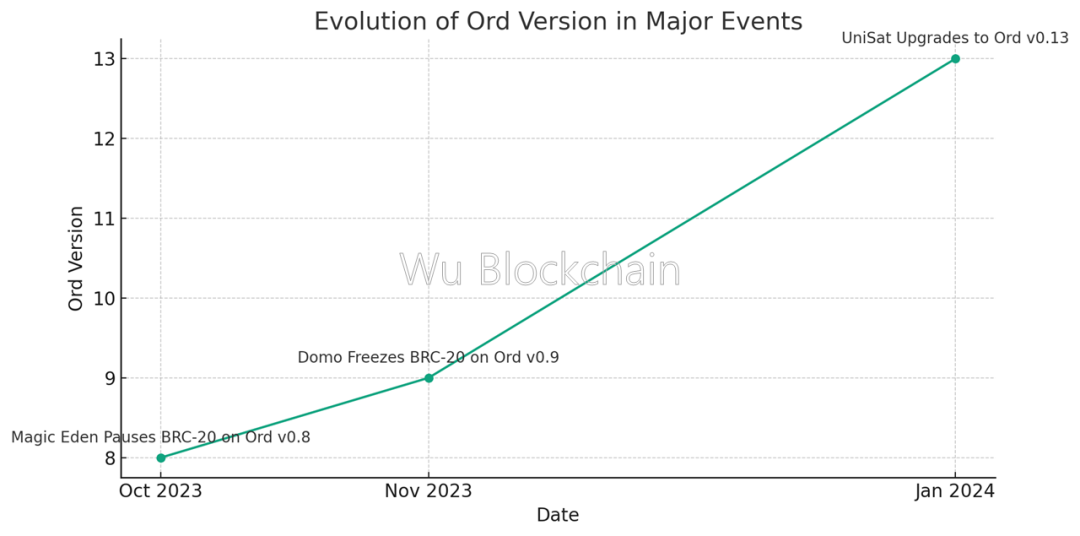
BRC-20 is based on the Ordinals protocol, but it is not native to the Ordinals protocol. When the Ordinals protocol faces an upgrade, BRC-20 will face the problem of whether the index will follow the Ordinals protocol upgrade. The index is essentially a consensus carrier. In order to maintain the stability of the index, domo will freeze BRC-20 in ord v 0.9 version in November 2023. However, with the development of the Ordinals protocol, earlier problems such as unrecognizable curse inscriptions have been fixed, and many new features have been introduced, which has left BRC-20 frozen in ord v 0.9 facing a big choice.
On January 3, 2024, UniSat, which has the largest index consensus in the market, chose to upgrade BRC-20 to follow Ordinals Jubilee, which was contrary to the original intention of BRC-20 creator domo. Domo criticized UniSat for forking BRC-20. The stability-maintaining faction of Layer 1 Foundation, led by BestinSlot and domo, and the upgrading faction such as UniSat and Ordinals Wallet, formed two forces on the BRC-20 issue. One is the creator, and the other is the largest index consensus. BRC-20 is facing an internal crisis of unprecedented magnitude. Although they had different opinions, the starting point for BRC-20 was good. After friendly communication between the two parties, domo and UniSat finally reached an agreement two days later on January 5, agreeing that BRC-20 would be upgraded along with Ordinals. OKX and Binance also support BRC-20 upgrades following the Ordinals protocol. Although the crisis was resolved in a short period of time, it also made people realize that assets derived based on the Ordinals protocol are prone to face the test of consensus split in the early stages of development.
(11) The diversified ecology of Ordinals inscription asset types cannot be ignored
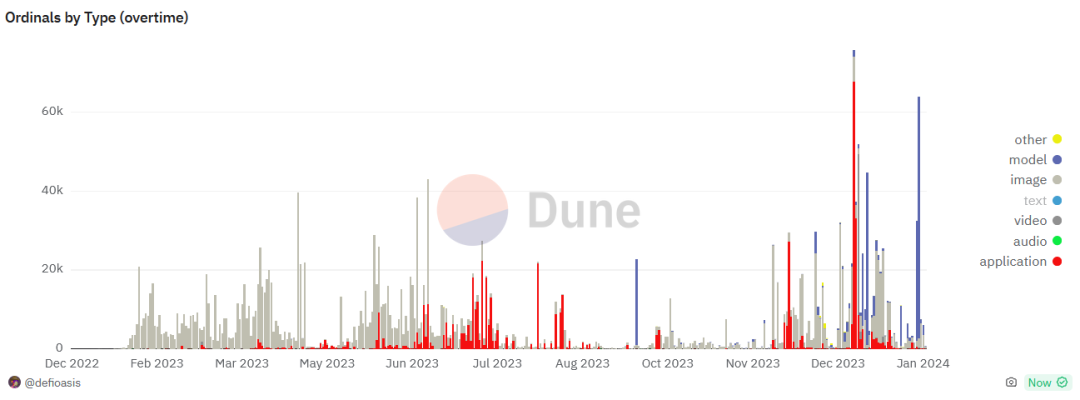
(Data source: https://dune.com/dgtl_assets/bitcoin-ordinals-analysis)
Although texts headed by BRC-20 occupy the absolute inscription type, other types of inscription assets have never stopped developing, and accurate positioning still has a small space for development. From Bitcoin Punks to Bitcoin Frogs to NodeMonkes, image-type assets represented by NFT have maintained a stable development trend. The completely on-chain and non-tamperable characteristics have returned to the essence of NFT collectibles; 3D model types represented by BRC-420 blue box The asset shows the imagination of building a metaverse on Bitcoin. On January 23, 2024, the number of model inscription assets minted reached a record high of 61,000; building applications on Bitcoin has become a reality.
(12) The Runes protocol proposed by the founder of Ordinals is highly anticipated

(Data source: https://geniidata.com/user/jonsnft/degen)
Tired of the negative consequences of BRC-20s massive increase in UTXO, Ordinals protocol founder Casey publicly criticized BRC-20 on social media on September 25, 2023, and proposed a new token to replace BRC-20. Standard protocol Runes. Runes balance is recorded and saved by UTXO, and one UTXO can contain any number of runes. Compared with BRC-20, UTXO-based Runes are more in line with the native characteristics of Bitcoin, reducing the harm caused by UTXO set expansion, and reducing the risk of consensus differentiation caused by relying on external indexes.
The official version Runes protocol mainnet launched by Casey has been scheduled to be launched at the next Bitcoin halving, but the Runes vision has been realized on some grassroots protocols, such as Rune Alpha, which deployed COOK rune tokens; led by Inscription model worker Benny The PIPE Protocol was launched, and rune tokens such as PIPE were born; RSIC is a new mining method, and the mining output is some kind of rune token after the Runes protocol is launched in the future.
(13) The Atomics protocol based on UTXO model shows potential

(Data source: https://dune.com/0x matsu 0x/atomicals-vs-ordinals)
In September 2023, after several months of polishing, Arthur launched the Ordinals improved protocol Atomicals based on the Bitcoin UTXO model. It has a GPU Bitwork mining mechanism and natively defines three asset types: NFT, ARC-20 and Realm. Among them, ARC-20 It is a Satoshi-dyed token standard where each ARC-20 token is backed by 1 Satoshi. Because it is closer to the original ecology of Bitcoin, Atomics is also considered by the community to have the potential to succeed Ordinals and start a new round of inscription ecological prosperity. Because it has the same name as the atom, the basic unit of matter, the Atomics agreement formed a physical MEME culture headed by ATOM, and most of the other ARC-20 are also named after physical terms. On January 1 and January 21, 2024, the minting activities of QUARK and SOPHON both pushed Atomics to surpass Ordinals in the number of single-day minting/deployments.
(14) Airdrops to Bitcoin degen players may become the norm, RSIC’s first high-value airdrop
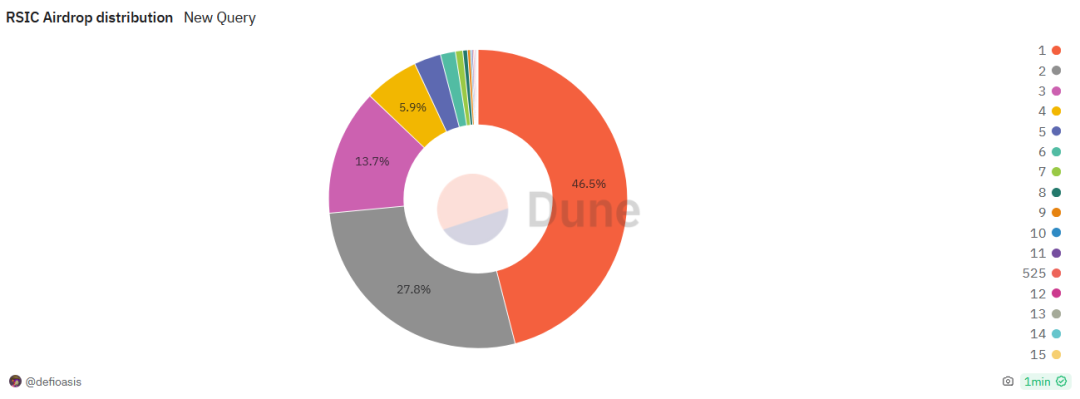
(Data source: https://dune.com/keyinotc/rsic-airdrop)
On January 22, 2024, RSIC airdropped a total of 9.27k addresses to Ordinals active addresses and blue-chip BTC NFT holders. The total supply of RSIC is 21,000, and the current floor price exceeds 0.036 BTC (approximately US$1,500). This is the first time that the Inscription project has carried out a cold start with a high-value airdrop. Airdrops to active Bitcoin players may become more and more normal in the future.
(15) Bitcoin expansion path exploration, BTC L2 ushered in a blowout

(Data source: https://bitvm.gitbook.io/cn/btc-layer2/overview/detail)
According to statistics from the BitVM Chinese community, there are currently more than 30 BTC L2s on the market. According to their characteristics, they can be divided into side chains, off-chain computing, rollup, data availability, status channels, client verification and others. Among them, side chains There are BEVM, MAP Protocol and Merlin Chain, etc., Rollup includes QED Protocol, BitVM and Bison, etc., data availability includes Veda and Nubit, status channel includes OmniBOLT and Lightning Network, client verification includes RGB, and others include Bool Network, Dovi and Bitfinity Network. wait. Ultimately, it is expected that more than 100 BTC L2 may be born in this cycle.
In just one year of the development of Inscription, various protocols and assets have emerged one after another. However, for the vast majority of early protocols, the infrastructure such as indexing and data is not yet complete, and I have limited data mining capabilities for some protocols. I cannot mention them all, so please forgive me.
refer to:
https://mp.weixin.qq.com/s/vIfc_CUKsQlCXBgkaF2VdA



